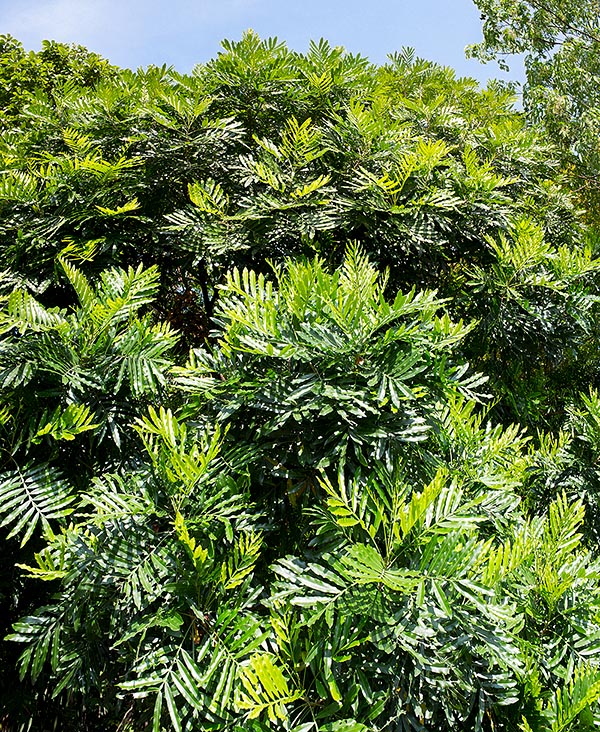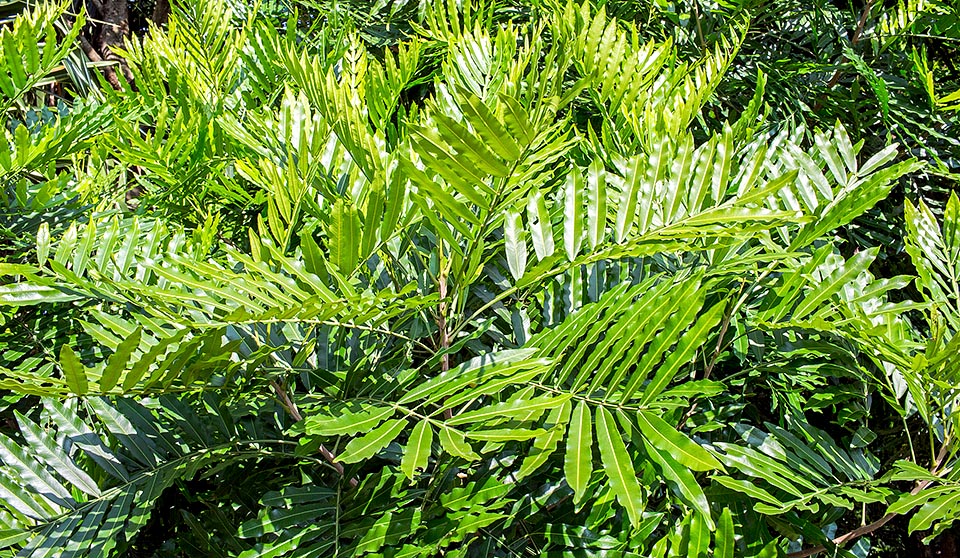Family : Sapindaceae

Text © Pietro Puccio

English translation by Mario Beltramini

Native to the humid forests of East Africa and India, the Filicium decipiens as an evergreen tree with the dense and roundish top © Giuseppe Mazza
The name of the genus comes from the Latin “filix, icis” = fern, the specific name from the Latin verb “decipio” = to fool, to deceive, due to the look similar to a fern.
Common names: fern tree, fern-leaved tree, Japanese fern tree, soap berry (English); katu (Hindi); kiara payung, ki sabun (Indonesian); kaadu hoovarasi, neeroli (Kannada); kattunelli, murriccha, niroli, valmurichcha (Malayalam); árvore-samambaia, felício, filício (Portuguese-Brazil); pihimbiya (Sinhala); mkong’o (Swahili); athadali, iruvillipalai, ningal, nirkongu (Tamil); patta kunkudu (Telugu).

Usually 5-10 m tall in the tropical gardens, it may exceed in nature the 25 m © Giuseppe Mazza
The leaves, on a 3-10 cm long winged petiole, are alternate, imparipinnate, 15-30 cm long and 12-15 cm broad, with winged rachis and 6-12 couples of opposite or sub-opposite leaflets, sessile, oblong-lanceolate with entire and slightly wavy margin, 6-12 cm long and 1-3 cm broad, coriaceous, of intense green colour and glossy above.
The inflorescences, on an about 7 cm long peduncle, are 15-30 cm long panicles carrying numerous tiny flowers unisexual and hermaphroditic (polygamous), of 0,4-0,6 cm of diameter. Pentaparted calyx with ovate imbricate lobes, deciduous, 5 orbicular petals white-greenish with pink shades, 5 stamina and bilocular ovary. The fruit is a fleshy ovoid drupe, apiculate, of about 1 cm of diameter, of reddish colour tending to dark blue when ripe, cointaining 1-2 seeds.
It usually propagates by seed, that must be planted in very short times having a reduced duration of germinability, in draining loam rich of humus maintained humid, but without stagnations, at the temperature of 24-28 °C; for speeding up the germination the seeds can be previously kept in water for one day.
The species, whose luxuriant foliage is considered as among the most ornamental by far, is cultivable in the tropical and humid subtropical climate regions, not bearing temperatures close to 0 °C unless exceptional and for very short time. Utilizable in parks and gardens, even if of small size, as isolated specimen, in group as shade tree, for barriers, even windbreaks, and in the street trees; seen that the fruits, when falling, may be annoying, it is preferable to place the tree enough away from alleys and sidewalks.
It requires an exposition in full sun or in partial shade and is not particular about the soil, provided draining, neutral to slightly alkaline. It has a good resistance to the saltiness, therefore can be employed close to the sea, and well rooted stands short periods of drought. The young plants, because of the beauty and elegance of the foliage, are often cultivated in pot, where they can be kept for long time, seen the slow growth, for the decoration of outer spaces and also of luminous inner ones where the climate does not allow the continuous permanence in open air, with lowest winter temperatures of not less than 16 °C.

The luxuriant foliage, considered as among the most ornamental in absolute, reminds the ferns, as well states the scientific name © Giuseppe Mazza
The species has a modest utilization in the traditional medicine, in particular in the Indian one the bark is used for treating fractures. Finally, the cut leaves are often utilized in the floral compositions.
Synonyms: Rhus decipiens Wight & Arn. (1834); Pteridophyllum decipiens (Wight & Arn.) Thwaites (1854); Jurighas decipiens (Wight & Arn.) Kuntze (1891); Filicium elongatum Radlk. ex Taub. (1895); Filicium decipiens f. apterum Capuron (1969).
→ To appreciate the biodiversity within the SAPINDACEAE family please click here.
